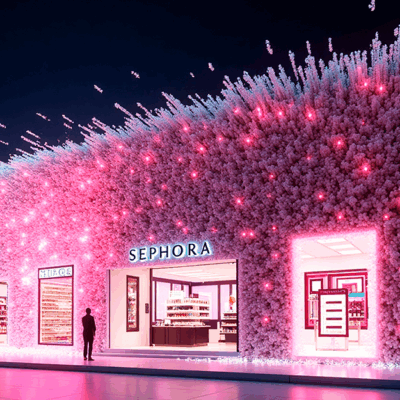
Fragrance Decanting Is Growing. Is It Hurting Or Helping Brands?
#PerfumeTok is engaged in a discussion about decanting by e-commerce websites that divide perfumes into smaller sizes for consumers to try at lower prices, with critics arguing that decants may be counterfeit and supporters countering that they’ve largely been reputable and enable consumers to affordably trial expensive perfumes.
As interest in fragrance has grown, so have decanting options from sites such as Scent Split, Surrender to Choice, Scents Angel, DecantX, Parfums de France, Decant Heaven and Scent Decant. On Scent Decant, a 1-ml. vial of Francis Kurkdjian Paris Baccarat Rouge 540 by Maison Francis Kurkdjian is priced at $5.99. On the brand’s official website, it’s $335 for an almost 71-ml. size. On Scent Split, a 1-ml. sample of Parfums de Marly’s Delina is $7.99. On the brand’s site, a 75-ml. bottle of the fragrance is $390.
According to data from Charm.io provided to the publication Women’s Wear Daily, 13- to 17-year-old fragrance lovers are flocking to sites like Decant Haven offering decants and samples. The e-commerce analytics platform finds that 15% of Decant Heaven’s social media followers are within the teenage age range. The desire for decants has trickled down to individual content creators on TikTok, who are divvying out portions of perfumes from their personal collections for fragrance-curious consumers.
Speaking to WWD, Alex Nisenzon, founder and CEO of Charm.io, said, “When we analyze fragrance brands that are popular among younger shoppers, what stands out is their ability to deliver accessible luxury. Most teenagers don’t have the budget for luxury perfumes, but they still crave that elevated experience.”
To further the decanting discussion, for this edition of our ongoing series posing questions relevant to indie beauty, we asked 10 fragrance entrepreneurs, executives and consultants the following: What are the pros and cons of the business of scent decanting? What’s your experience with decanting? How should fragrance sampling evolve? Are you trying anything that you’ve found successful?
- PAMELA VAILE President and Founder, Pamela Vaile Consulting LLC
I am cautious when it comes to fragrance web stores taking on the decanting process because I am not sure how the product has been handled. These are highly sensitive alcohol solution formulas that can absolutely be tainted if they are improperly decanted.
I trust Scentbird. The indie fragrance brands that I work with send bulk, and they fill their sampling vials at an approved production facility. I know the Scentbird product is high quality when it reaches the consumer.
At a fragrance website that is decanting from a brand's fragrance bottles, I have a concern. I don’t know what they are doing. Are they decanting in a temperature-controlled environment? Are they sanitizing equipment?
I am generally not in favor of decanting fragrances even at the retail counter. It’s something that I am cautious about. If an established brand is doing it for you, you can feel comfortable with how they are managing the process for their brand and ensuring the proper quality control of the fragrance.
The gen Zalpha customer is driving the need for smaller bottles of fragrance. They are buying discovery kits so they can layer and experiment with fragrances. Research at Sephora and Ulta tells us that the average gen Zalpha consumer is wearing eight to 12 fragrances a month.
They are an engaged audience of fragrance lovers who want to explore a wide range of new olfactive trends. They love small trial sizes, which give them an inexpensive entry price point. At a $20 price, they will buy five new fragrances, but they don’t want to spend $350 on one new fragrance. This is also a pattern because this younger consumer is generally looking to play with fragrance and not with a heavy financial burden.
Brands have done a good job with discovery kits for them. This is what is fueling the fragrance business and will ultimately lead to customers buying larger sizes. However, I think the small size phenomenon is here to stay.
- Emilie Mascarell Founder and Product Development Consultant, Maison Mascarell and Emilie Consulting
I understand the appeal of decanting, especially with fragrance prices rising. Spending over $150 on a scent you’ve never smelled is a big ask. Fragrance is deeply personal, and there still aren’t enough ways to try before buying. Decants help make discovery more accessible.
That said, I do have concerns around authenticity and quality. I’ve seen decant orders come through for brands I’ve worked with, so I know some are legitimate, but I still wonder if all decanters are sourcing directly from the brands. And without oversight on how the fragrance is stored or how long it’s been sitting, it’s hard to know if the scent is still true to how it was meant to be experienced.
I appreciate when retailers like Luckyscent offer in-house decants, and I’d love to see similar options from more retailers. Some brands now include a sample with full-size orders, which is thoughtful, but, if it doesn’t work out, the return process can feel wasteful and place the responsibility back on the customer.
People are layering, experimenting and wearing fragrance more fluidly. Sampling options should reflect that. With more brands now selling samples directly, there’s not only a chance to increase revenue, but also an opportunity to tell a fuller brand story and convert new customers.
- Miranda Gordon Chief Creative Marketing Officer, Punk Champagne
I support decanting that drives purchase conversion. One or two milliliters is enough to smell it on blotter and try it on skin and see if you like it enough to buy a full-size product. As an industry professional and as a lifelong fragrance junkie, I depend on these tiny samples to educate myself about the thousands of new fragrances that hit the market and to determine which are worth getting to know better.
Luckyscent, Microperfumes and Smallflower are organizations that I count on to support my needs and to support the distribution needs of the brands that they sell. That said, I despise the vials themselves. I struggle to open them without spilling them, contorting the plastic caps or breaking the glass. Surely there’s a brilliant, innovative packaging engineer who wants to solve this problem with an eco-friendly, easy-fill, easy-open, shipping-ready solution!
I’m troubled by for-profit subscription dramming services, which are not designed for purchase conversion. They’re a textbook definition of low-end disruptive innovation in that subscription services are filling market demand for more affordable, accessible versions of existing products.
That opportunity represents lost revenue for brands who aren’t providing smaller, more affordable sizes themselves. Branded paid sampling is the answer, but luxury brands need the support of packaging manufacturers to maintain brand integrity. Beautifully designed samples in precious, giftable discovery kits are one solution, but kits can be costly.
Branded travel sizes are another opportunity. Remember the beautiful miniature bottles we used to get for free at beauty retail? Free samples became cost prohibitive, but I’d love to see the industry bring back the minis—adorable! precious! brand-specific!—and charge for them. Sampling doesn’t need to be a loss leader if the samples are objects of desire.
- Kim Charles Owner, Indult Paris
On the pro side, decanting makes niche perfumes more accessible. Not everyone can drop that kind of money upfront or commit to a full discovery set just to try something new. So, we’ve been OK with it for years!
But it’s starting to get messy. Some customers have bought decants thinking they were authentic, only to end up disappointed with something that wasn’t our juice. And now with aggressive marketing and a race for volume, it’s starting to feel like a gray market. When it’s done cleanly and respectfully, great, but, in some cases, it starts getting tricky because it bypasses brand control entirely!
As for the evolution, we believe in offering access through free sampling, We’re doing free 3-ml. samples through retail stores, but, geographically, it still doesn’t fully solve the issue.
- BART SCHMIDT Managing Partner, Brands With Purpose
I usually try to find the brand’s own samples or discovery sample kits online. If I can’t find it there, I’ll check Scentbird, the No. 1 sampling company. If that doesn’t work, then I’ll try some other reputable sources.
I’ve used Scent Split and DecantX, which has been a positive experience and helps to keep track of the constant evolving indie/niche market. I’ve also seen pics online of the fragrance.com decant vending machine in The Oculus, but haven’t tried it yet. I wouldn’t mind seeing more vending machines pop up in different areas, especially in partnership with the brands.
- Raffaella Grisa Founder, Wa:it
Scent decanting is a nuanced topic. On one hand, it offers a valuable entry point into the world of perfumery, especially for consumers who are curious about niche fragrances but not yet ready to invest in a full-size bottle. Platforms like Scent Split help broaden access and awareness in a way that can be meaningful and respectful when done transparently.
That said, preserving the integrity of a fragrance experience is essential. For us, a perfume is more than just its formula, it’s a ritual, a message and an emotion captured in a bottle. When decanting is done without care or accountability, there’s a risk of misrepresenting the product or compromising the quality, which ultimately affects trust in the entire category.
Sampling is evolving, and I believe the future lies in models that prioritize authenticity, traceability and collaboration between brands and retailers.
- Chris Calvosa Principal, Punk Champagne
A parallel between the business model of the dramming companies and the recent history of the music business may be relevant and, perhaps, prescient for the perfume business. In December of 1999, the Recording Industry Association of America sued Napster for copyright infringement because Napster was providing copyrighted music to users without the license that is granted via purchasing the music.
Napster was shut down in 2001, but now, less than 20 years after the genie of music downloading was released from its bottle, the entire business model of music has shifted. Music sales are overwhelmingly driven by downloads. The sales for vinyl records are the only full product physical sales that are growing. With this in mind, it’s surprising that the perfume business is ignoring the risk that dramming services represent. These services could cannibalize fragrance the way Napster gormandized physical music sales.
The rise of Napster was the harbinger of a shift—a regression—in music back to the singles-driven model that existed prior to the boom of singer-songwriters and LP-driven sales in the 1960s and 1970s. While the modern music business has infrastructure that enables customers to pay for downloading tracks, that model does not compensate most artists fairly.
Similarly, while legitimate dramming companies are buying authentic fragrances at retail, thereby generating revenue for the brands, is the industry training fragrance fans to eschew its hero products and buy the equivalent of singles instead of albums? Does the fragrance world need to be seeking the equivalent of vinyl—something special, something collectible—to incentivize customers to buy full products and secure the continuance of full-sized products?
If not and the dramming genie cannot be put back in its bottle, should the perfume industry double down on paid sampling with formats like vials-on-card and discovery kits, so they don’t have to surrender revenue to the dramming companies?
Customers tend to communicate how they want to buy, and today’s fragrance customers are signaling they want small, low-commitment product sizes. Right now, full product sales are still strong and the middle market for the dramming companies is growing, but the perfume industry needs to be mindful of the lessons from the music business’s Napster era and how that moment completely redirected the music business.
- Cristina Bagozzi Founder, Emmotiv
I am generally ambivalent about the concept. On one hand, I understand the appeal: easy, cost-effective access to luxury and/or niche fragrances plus an element of fun, playful discovery for fragrance enthusiasts that translates well into engaging TikTok content.
On the other hand, as a brand owner, I would not feel comfortable with Emmotiv fragrances being sampled this way. There is no way to guarantee the quality and legitimacy of the product. To be clear, this does not apply to platforms that collaborate with/source pre-made samples directly from brands. Nonetheless, the rise of these sites highlights a growing consumer desire for help navigating the saturated, trending fragrance category.
Ultimately, people need to experience a fragrance on their own skin to see if it’s the right fit for them. What has worked well for Emmotiv with a limited sampling budget is a combination of: 1). a reasonably priced discovery set available on our website that includes a credit customers can apply towards the purchase of their favorite full-size fragrances, and 2). IRL trial through Emmotiv's retail partners.
- Aba Gyepi-Garbrah Founder, Aba Love Apothecary
The pros of decanting are that it gets consumers excited and seeking fragrance. The consumer doesn't have any financial barriers to the coveted scents they are after. The consumer can be as free and playful as they like with scent as “fragrance wardrobes” grow in popularity.
The cons are that it draws the consumer away from the brand experience and draws out the time which the consumer connects to the brand directly, when a consumer finally decides to commit to the full bottle. And there are authenticity challenges. With all the dupes out in the wild, my guess is that it could be difficult for a newbie consumer to know if what they are getting is genuine and authentic.
Many years ago as a hobbyist, Luckyscent was my go-to for trying new scents and seeking out new brands. They are an example of a genuine source as they are wholesaling directly with the perfume brands.
Brands should create their discovery scent launches and marketing right alongside their full-size bottle launches. And there are some notable fragrance buffs that hold community events such as scent swaps and perfume tours. Asia Grant, the “Perfume Room” podcast and Muse Modern Urban Sensory Experiences come to mind. I feel that there is an opportunity for brands to link arms.
- Ashlee Posner Founder, State of Change and Lucent Labs
The Pros:
Decanting has clearly democratized access. It’s opened the door for more consumers to experiment, especially with niche and high-end fragrances that would otherwise be out of reach. It’s also filled a major gap left by traditional sampling programs, which often push the cost and logistics burden onto brands.
The Cons:
The biggest issue is trust, not just around authenticity, but around stability and safety. Once a fragrance is decanted, it’s removed from its original packaging, which was designed to preserve the formula and ensure safety testing. That exposure to light, heat, air or contamination can alter the scent, how it wears and even how allergens present. Consumers often assume it’s just a “smaller size,” but it’s actually a chemically more vulnerable version.
Where It Should Go Next:
Sampling is overdue for innovation, not just in format, but in transparency and traceability. The future of sampling should be trackable, attributable and come with embedded ingredient data, safety info and a direct purchase CTA.
There’s enormous energy in this space—and consumer demand is clear. What we need now is the infrastructure to match that demand safely, sustainably, and with integrity.
Sampling has already moved beyond being a throwaway step. Post-decanting, it now needs to evolve into something much smarter: a conversion tool and a compliance filter.
If you have a question you’d like Beauty Independent to ask beauty entrepreneurs, executives and consultants, please send it to editor@beautyindependent.com.






Leave a Reply
You must be logged in to post a comment.